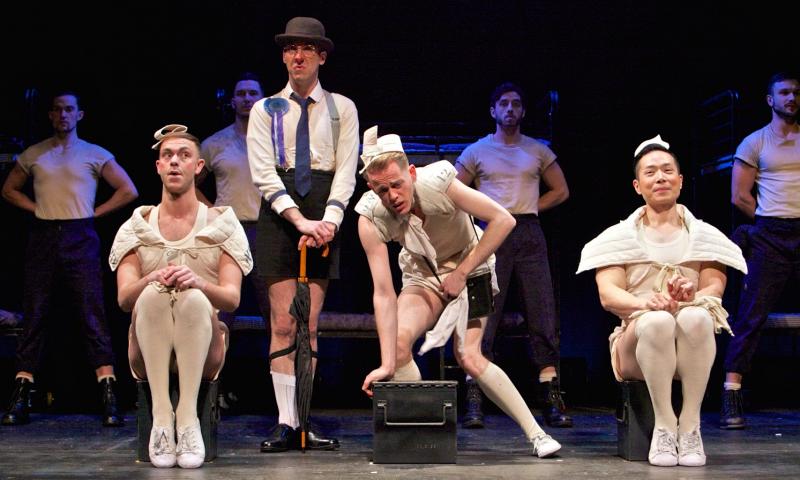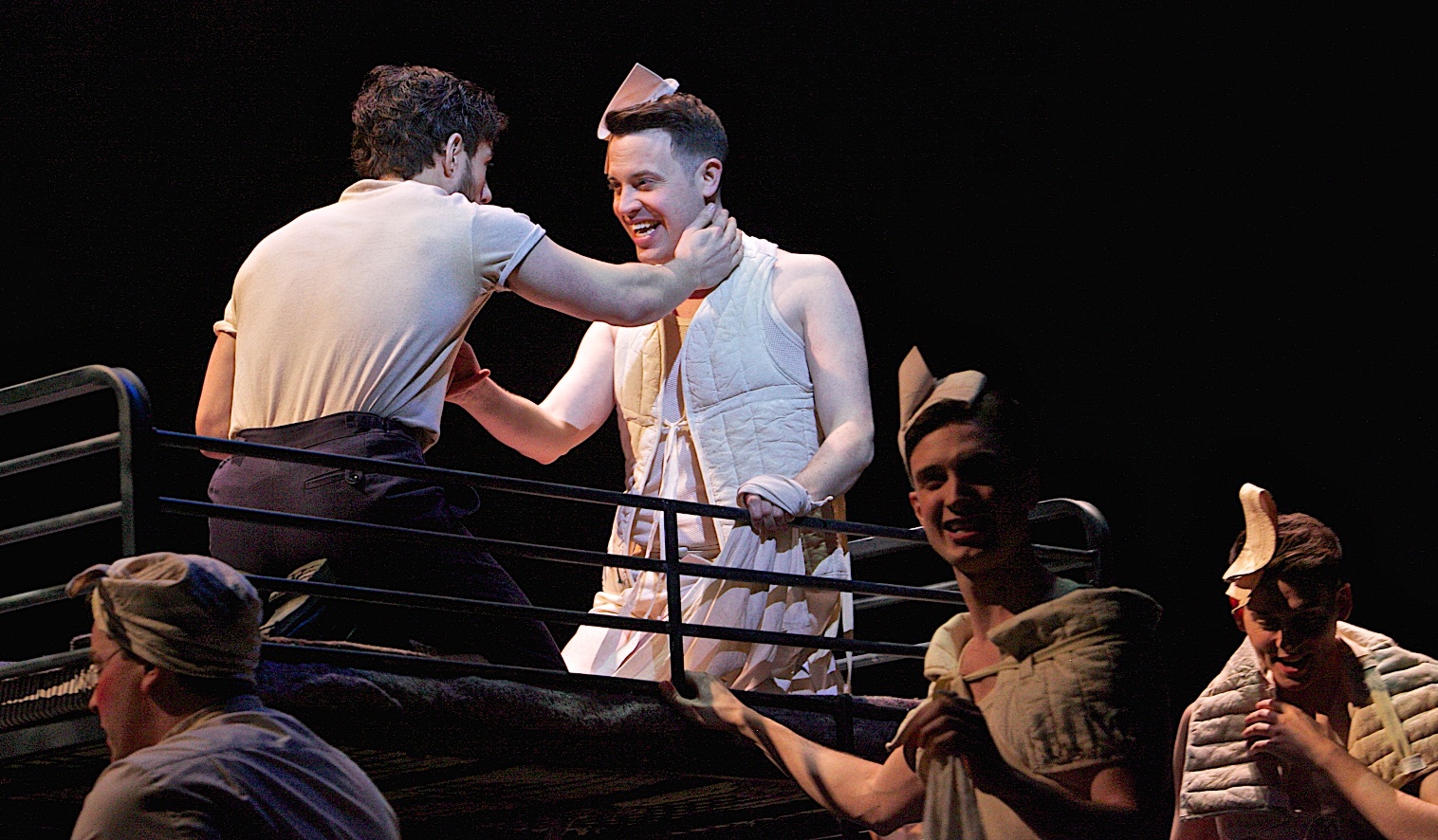HMS Pinafore, Hackney Empire | reviews, news & interviews
HMS Pinafore, Hackney Empire
HMS Pinafore, Hackney Empire
All-male G&S has familiar trademark fun, but weak links and big venue mute the pleasure

Showboys will be boys – gym-bunny sailors, in this instance – as well as sisters, cousins, aunts, captain’s daughters and bumboat women. We know the ropes by now for Sasha Regan’s all-male Gilbert and Sullivan: a loving attempt to recreate, she says, the innocence of musical theatre in same-sex schools (mine, for which I played Sir Joseph Porter with a supporting army or navy of recorders, two cellos and piano, was mixed).
This time, the naval high jinks allow Regan to evoke a kind of Privates on Parade scenario, the show-without-the-show set below deck on a World War Two battleship – or so we’re told, though it’s not a great deal clearer than the school dorm context of her Iolanthe. But there nobody minded because the casting and the surprising pathos were perfectly nuanced. Here, what deeper sentiment there is works well in the experienced hands of Alan Richardson’s class-conscious Josephine, but Pinafore is smaller grog than the longer, richer Iolanthe. Two roles are not so strongly taken and the vasts of the Hackney Empire, beautiful as it is, defeat so much of what must have worked so well in the intimate space of the Union Theatre (my fault for not seeing it there).
 Devotees – and, indeed, newcomers – should be well satisfied by the company routines, neatly choreographed by Lizzi Gee to accompany most of the solos as well as the ensembles; they're so much better than the more-is-less overkill of Scottish Opera's mostly unfunny Pirates of Penzance. Much play is made with a barrier rope: most amusing as Alex Weatherhill’s understated, coy Little Buttercup hints at dark secrets to the Captain Corcoran of Neil Moors, whose "what never?" "hardly ever" entrance number (pictured above) takes the working-out stuff to brilliantly executed heights. The chorus bifurcates delightfully into sailors and the First Lord’s fluttery entourage in Sullivan’s clever double chorus, and Sir Joseph Porter’s arrival brings with it a show-stealing characterisation of the usually colourless, here much exploited Cousin Hebe by Richard Russell Edwards.
Devotees – and, indeed, newcomers – should be well satisfied by the company routines, neatly choreographed by Lizzi Gee to accompany most of the solos as well as the ensembles; they're so much better than the more-is-less overkill of Scottish Opera's mostly unfunny Pirates of Penzance. Much play is made with a barrier rope: most amusing as Alex Weatherhill’s understated, coy Little Buttercup hints at dark secrets to the Captain Corcoran of Neil Moors, whose "what never?" "hardly ever" entrance number (pictured above) takes the working-out stuff to brilliantly executed heights. The chorus bifurcates delightfully into sailors and the First Lord’s fluttery entourage in Sullivan’s clever double chorus, and Sir Joseph Porter’s arrival brings with it a show-stealing characterisation of the usually colourless, here much exploited Cousin Hebe by Richard Russell Edwards.
The weak links are Aidan Crowley’s way-OTT Dick Deadeye and Keith Jack’s Ralph Rackstraw; the unusually eloquent seaman, an upper-class infant switched with a child of the lower orders by erstwhile baby-farmer Buttercup (I trust no spoiler notice is needed), ought to deliver his poetic speeches to the lass above his station with far more stylised aplomb, and his arietta calls for a sweet tenor, not a straining show voice. Moors is also guilty of belting out what should be a low-key romance at the beginning of Act Two.
 David McKechnie’s Sir Joseph is a crisp, professional piece of work, though never likeable (and I’m not sure the arselicking political operator who never thought of thinking for himself at all, and never went to sea, is supposed to be). The star, undoubtedly, is Richardson’s daughter of the waves (pictured above with Jack's Ralph), beautifully balanced with deft gestures between sadness and snobbery; and while some of the notes in the hard-working falsetto are inevitably squeezed, he hits the heights with the aplomb of a bravura countertenor.
David McKechnie’s Sir Joseph is a crisp, professional piece of work, though never likeable (and I’m not sure the arselicking political operator who never thought of thinking for himself at all, and never went to sea, is supposed to be). The star, undoubtedly, is Richardson’s daughter of the waves (pictured above with Jack's Ralph), beautifully balanced with deft gestures between sadness and snobbery; and while some of the notes in the hard-working falsetto are inevitably squeezed, he hits the heights with the aplomb of a bravura countertenor.
Although Ryan Dawson’s bunk-bed design and Tim Deiling’s lanterns cleverly fill a large stage, and the near-darkness for the attempted elopement of Ralph and Josephine is wittily manipulated, the Empire is no substitute for the intimacy of the Union or even Wilton’s where Iolanthe wrought a special magic. While the mess's resident recorder-player gives a haunting summons and farewell to the let's-put-on-a-show, hard-working Richard Bates’s piano accompaniment sounds tiny even when miked – a second piano is a must, in Hackney at least – and needs more classical zip (only listen to the Mackerras recording). The choruses can be forced. Tour venues, at least, will embrace all shapes and sizes, so do go if your local theatre isn’t too big. If you haven’t seen the Regan Savoy opera style, you’re still bound to be impressed. Me, I'm back to the Union at the first opportunity.
rating
Share this article
The future of Arts Journalism
You can stop theartsdesk.com closing!
We urgently need financing to survive. Our fundraising drive has thus far raised £49,000 but we need to reach £100,000 or we will be forced to close. Please contribute here: https://gofund.me/c3f6033d
And if you can forward this information to anyone who might assist, we’d be grateful.

Subscribe to theartsdesk.com
Thank you for continuing to read our work on theartsdesk.com. For unlimited access to every article in its entirety, including our archive of more than 15,000 pieces, we're asking for £5 per month or £40 per year. We feel it's a very good deal, and hope you do too.
To take a subscription now simply click here.
And if you're looking for that extra gift for a friend or family member, why not treat them to a theartsdesk.com gift subscription?

Add comment